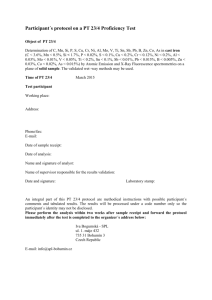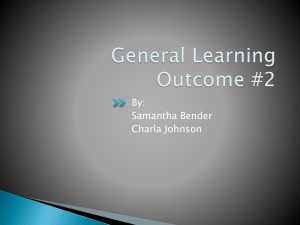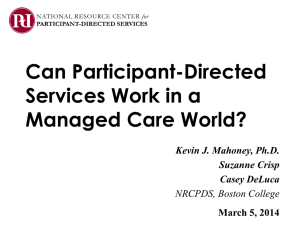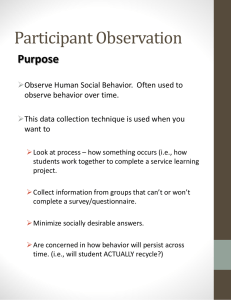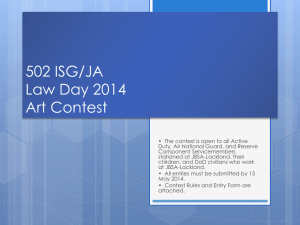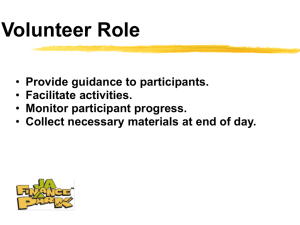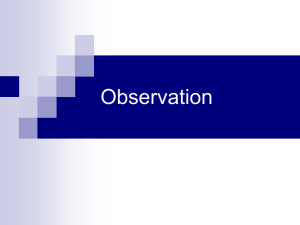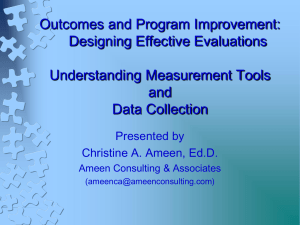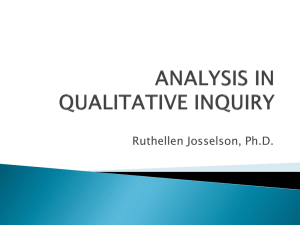Notes: MoneySmart - "Charge it Right!
advertisement
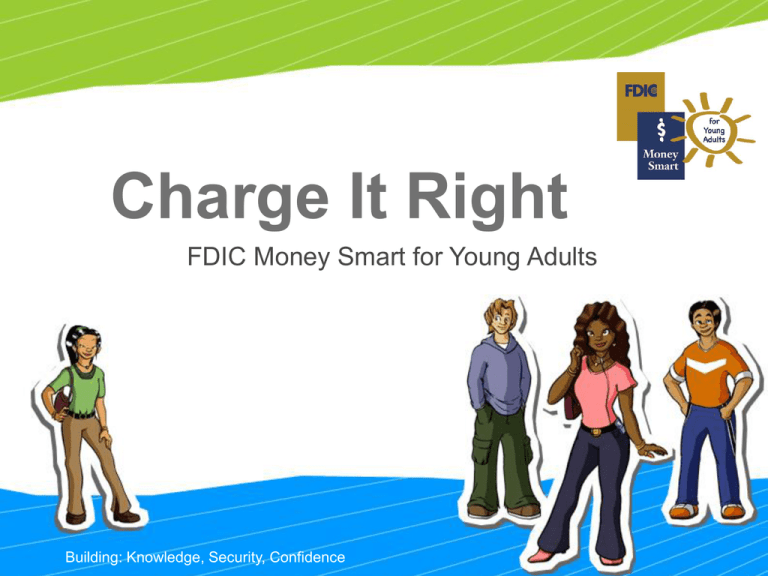
Charge It Right FDIC Money Smart for Young Adults Building: Knowledge, Security, Confidence Purpose • First steps to financial security: • Planning and following through on a personal spending plan or budget • Budgeting is about choices, how to: • Make money • Spend money 2 Objectives By the end of this course, you will be able to: • Describe the purpose of credit cards • Analyze credit card solicitations • Determine which credit card is best for you or if a credit card is a good option for you • Identify factors credit card companies look for when making credit decisions • Describe how to use a credit card responsibly • Identify steps to take when a credit card is lost or stolen • (Tell how to) Guard against identity theft 3 Cash, Credit, or Don’t Buy? 4 Credit Card Characteristics • Convenient form of borrowing • Provide a revolving line of credit • Require a minimum payment each month 5 Activity 1: Credit Cards and Debit Cards Complete Activity 1 in your Participant Guide – Look at the chart – Review the difference between credit cards and debit cards 6 Stored Value Cards and Smart Cards • Similar to retailer gift cards • Work like a debit card • Deposit money and the balance declines 7 Stored Value Cards and Smart Cards (cont’d.) • Telephone cards • International gift cards • Payroll cards • Retail gift cards 8 Activity 2: Which Card is This? Complete Activity 2 in your Participant Guide Select the best answer: –Cash cards –Smart cards –Stored value cards 9 Secured and Unsecured Cards Secured Cards • Require collateral or a deposit to obtain credit • Can get secured credit with no credit history or a negative history 10 Secured and Unsecured Cards (cont’d.) Unsecured Cards • Do not require collateral or a deposit to obtain credit • Usually need a good credit history 11 Student Credit Cards • Low (or no) introductory interest rates • Cash back bonuses • Some offer no income requirements and no co-signer needed • Typically a low credit limit • Often no annual fee 12 Rewards Cards • Are offered by hotels, airlines, and/or your credit card company directly • Earn points for amounts charged on the card toward free or discounted travel, hotel, or other goods and services • Usually charge an annual fee • May give cash rebates 13 Pre-Approved Card Offers • Offers from creditors that you might be able to get the advertised interest rate and limit based on viewing your credit report • Actual terms depend on income, working status and credit history • Shop for the best terms 14 Some Quick Statistics • 18-24 year olds declaring bankruptcy 96% increase in the last decade • In 2002: 15 More Statistics • 2001 = 83% of college students had at least one credit card: – Average student had four! • 71% of young adult card holders do not pay off their balance in full each month • Graduating College seniors had an average of nearly $4,000 in credit card debt: – 134% from 10 years ago 16 Pre-Approved Offers • You are “pre-approved” but must still qualify for the card • Read the agreement carefully • Shop around! Don’t always take the first offer 17 Activity 3: How Do They Target You? Complete Activity 3 in your Participant Guide – Read the information – Review the different ways credit card companies try to earn your business 18 Shopping for the Best Deal Credit cards have different terms: Annual percentage rate (APR) Fees Cash Balance Balance advance transfer Grace period computation requirements requirements method and fees and fees 19 APR (Annual Percentage Rate) • APRs are fixed or variable • Penalty APRs are about 52% higher than regular APRs • Credit card companies must state how long introductory APRs last 20 APR (Annual Percentage Rate) (cont’d.) • Penalty APR An increase in the APR if a payment is made late • Universal Default If you are late paying other loans, your rate increases on the card with the universal default policy, even if that payment was not late 21 Fees • • • • • Annual fees Late fees Over-the-limit fees Balance transfer fees Cash advance fees 22 Grace Period • A specified number of days to pay your balance before the credit card company starts charging interest 23 Free 25 days Grace Period Costing you money! Balance Computation Method • States how interest is determined • Most common is the average daily balance method 24 Cash Advance Ability to get cash from your credit card Usually a fee for this service Example: “2%/$10” means 2% of the cash advance amount or $10, whichever is more APRs on cash advances are typically much higher 25 Balance Transfer • Moving unpaid debt from one card to another • Encouraged by some companies using low rates on transferred balances 26 Truth in Lending Disclosure • Legally required • States all credit card terms, including: – – – – APR Fees Grace Period Other terms 27 Activity 4: What’s the Best Offer? Complete Activity 4 in your Participant Guide – Read each offer – Use the Truth in Lending Disclosures to answer the questions 28 Other Factors to Consider • Customer service • Additional protection 29 Activity 5: Credit Card Comparison Chart Complete Activity 5 in your Participant Guide – Review the sample – Compare different offers by filling in the chart for each one 30 Tips to Think About When Choosing a Card • How and when you will use the card • Start small • Understand the terms before you accept the card • Beware of introductory rates • Beware of application fees • Understand fixed and variable rates 31 Application Requirements • Individual credit – based on assets, income, and credit history • Joint credit – based on assets, income, and credit history of two people who apply • Typically, you must be at least age 18 to apply 32 Credit Report A record of how you paid your debts… • • • • • Who you are How much you owe If you make payments on time How often you apply for credit Any negative information of public record • Inquiries made about you 33 Credit Reporting Agencies • Equifax • Experian • TransUnion www.annualcreditreport.com 34 Activity 6: Annual Credit Report Request Form Complete Activity 6 in your Participant Guide – Review the form – Understand the purpose of the form 35 Credit Score • Determines credit risk • Determined by your credit report • Two types –FICO –VantageScore • Check your score before applying 36 FICO Score • Scores range from 300 to 900 • The higher your score, the better • Takes into account: – Payment history (35%) – Debt (30%) – How long you’ve had credit (15%) – New applications for credit (10%) – Types of credit (10%) 37 VantageScore • • • • New as of March 2006 Used by all three reporting agencies Scores range from 501 to 990 Number score goes with a letter grade – Example: 501-600 = F, 901-990 = A • Should be the same score from each agency 38 Denial Notice Tells why credit is denied: • Poor credit history • Not at current address or job long enough • Income not high enough • Also called an “adverse action” notice 39 Using Your Credit Card Responsibly • Protect your card and account numbers • Tear up or shred receipts with numbers on them • Keep a record of your account information • Carry only the cards you think you will use • Pay off your balance monthly • Do not exceed your credit limit 40 Activity 7: Credit Card User Case Studies Complete Activity 7 in your Participant Guide – Read each scenario – Determine if the credit card use is responsible or irresponsible – Explain why you think so 41 Lost or Stolen Credit Card • Do not give personal or account information over the phone • Lost or stolen - Notify the credit card company immediately • Suspect fraud - Notify the credit card company immediately 42 Paying Your Bill: The Credit Limit • The maximum amount the creditor is lending you • If you go over the limit, you will likely be charged overthe-limit fees 43 $ Fees $ Credit Limit Activity 8: Cost of Making the Minimum Payment Complete Activity 8 in your Participant Guide – Review the items in each table – Use the formula given to find out how much you really pay for an item after interest is added 44 Activity 9: Benefits of Making More Than the Minimum Payment Complete Activity 9 in your Participant Guide – Review the items in each table – Use the information to answer the questions 45 Credit Card Statement • Front – Shows detailed activity that happened for that billing cycle • Back – Describes terms, how interest is calculated, and contact information 46 Activity 10: Sample Credit Card Statement Complete Activity 10 in your Participant Guide – Review the sample – Use the statement to answer the questions 47 WOW: Banks Do a LOT! 48 Congratulations! Congratulations! You have completed the Charge It Right module. You have learned: • The purpose of credit cards • How to find available offers • How to decide if a credit card is good for you and if so, which is the best one • What credit card companies look for before they issue you a credit card • How to use a card responsibly and how to safeguard against theft 49 Assess Your Knowledge Don’t forget to complete the Knowledge Check in your Participant Guide! 50
